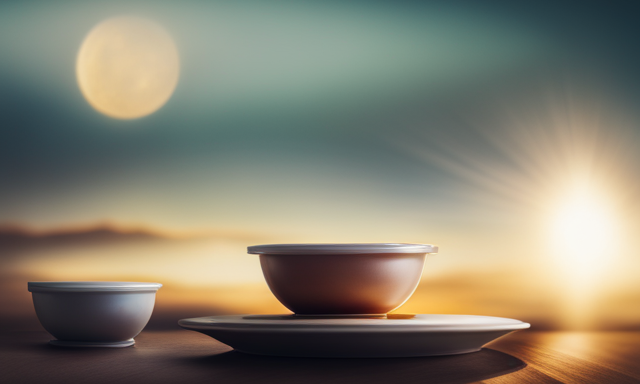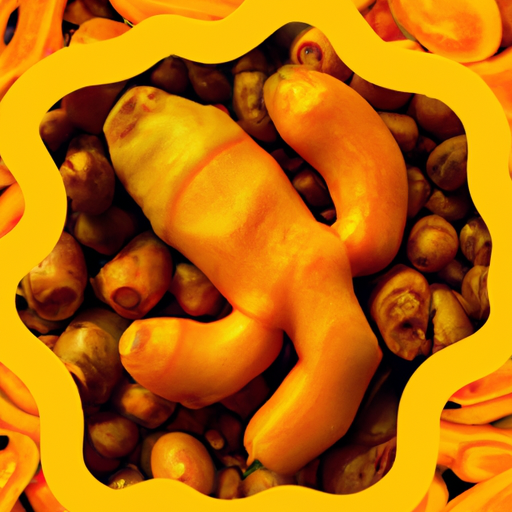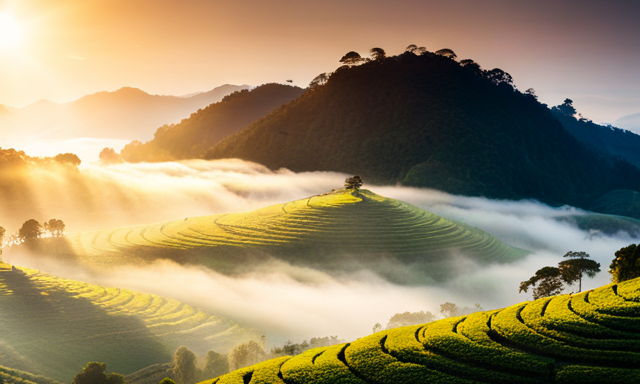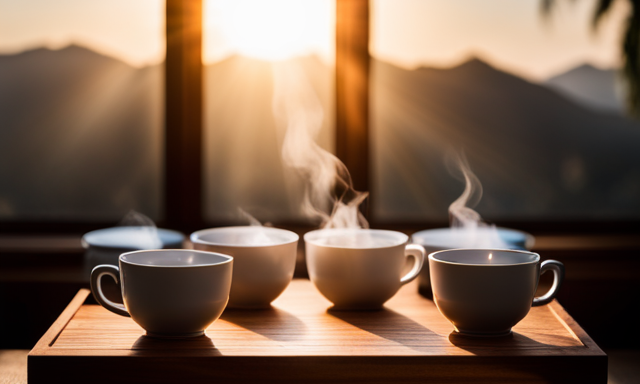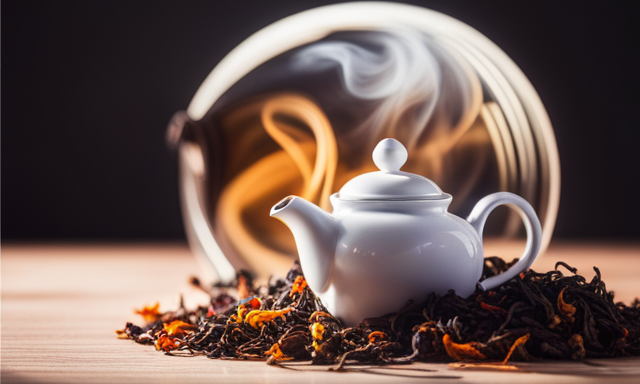So you think all teas are created equal? Well, my friend, think again! When it comes to the world of tea, there are countless varieties, each with its own unique characteristics and flavors.
In this article, I will delve into the fascinating world of oolong tea and explore how it differs from its well-known sibling, green tea.
Now, I know what you’re thinking – ‘What’s the big deal? They’re both just teas, right?’ Wrong! Oolong tea and green tea may come from the same plant, but they undergo different processing methods that result in distinct flavors and aromas. From the cultivation to the brewing techniques, every step of the journey contributes to the final product.
So if you’re a tea enthusiast like me, grab a cup of your favorite brew and join me on this enlightening journey. By the end of this article, you’ll be able to appreciate the subtle nuances that set oolong tea apart from green tea and make an informed choice based on your personal preferences.
Key Takeaways
- Oolong tea is partially oxidized, while green tea is not oxidized at all.
- Oolong tea has a delicate and floral taste with a slightly sweet aftertaste, while green tea has a fresh and grassy flavor.
- Oolong tea aids in weight loss, improves heart health, and boosts metabolism, while green tea aids in weight management and improves heart health.
- Oolong tea generally contains less caffeine than green tea, and it is cultivated in China and Taiwan.
Processing Methods
If you’re curious about how oolong tea differs from green tea, you’ll be delighted to know that their distinct flavors and aromas are a result of their unique processing methods. Both teas come from the same plant, Camellia sinensis, but oolong tea undergoes a more complex process than green tea.
Oolong tea leaves are partially oxidized, whereas green tea leaves are not oxidized at all. This difference in processing leads to variations in flavor and aroma. Oolong tea has a delicate and floral taste with a slightly sweet aftertaste, while green tea has a fresh and grassy flavor.
Additionally, oolong tea has been found to have numerous health benefits, including aiding in weight loss, improving heart health, and boosting metabolism.
Moving on to flavor profiles, let’s explore how these teas differ in taste.
Flavor Profiles
While both oolong and green tea offer distinct taste experiences, their flavor profiles showcase notable variations. Oolong tea is known for its complex and nuanced flavors, ranging from floral and fruity to woody and nutty. The brewing techniques for oolong tea play a crucial role in bringing out its unique flavors. Green tea, on the other hand, has a fresh and grassy taste with a slightly bitter undertone. Its flavor profile is influenced by the minimal processing it undergoes. When it comes to health benefits, both teas are packed with antioxidants and can aid in weight management and improving heart health. Transitioning into the next section about caffeine content, it’s important to note that oolong tea generally contains less caffeine than green tea.
Caffeine Content
Oolong tea has a moderate amount of caffeine, making it a great option for those who want a gentle energy boost without the jitters. On the other hand, green tea has lower caffeine levels compared to oolong tea, making it a popular choice for those who are more sensitive to caffeine or prefer a milder stimulant.
Both teas offer unique flavor profiles and health benefits, so choosing between the two ultimately comes down to personal preference and caffeine tolerance.
Oolong tea’s moderate caffeine levels
For a tea lover like you, you’ll be pleased to know that oolong tea has moderate levels of caffeine, which can give you a gentle boost of energy without overwhelming your system. Here are three reasons why oolong tea’s caffeine content is just right:
-
Oolong tea’s weight loss properties: Oolong tea has been shown to aid in weight loss by boosting metabolism and increasing fat oxidation. So, not only can you enjoy a cup of oolong tea for its taste, but it may also support your weight loss goals.
-
Green tea’s antioxidant benefits: While green tea is often praised for its high antioxidant content, oolong tea also contains beneficial antioxidants. These compounds help protect your body against free radicals and may contribute to overall health and wellbeing.
-
A balanced pick-me-up: Oolong tea’s moderate caffeine levels provide a gentle and sustained energy boost, making it an excellent choice for those who want to stay alert without the jitters or crash associated with higher caffeine beverages.
As we transition to the next section on green tea’s lower caffeine levels, you’ll discover another reason why oolong tea stands out in the world of tea.
Green tea’s lower caffeine levels
Contrary to popular belief, the caffeine levels in green tea are significantly lower than in other types of tea. Green tea contains approximately 25-35 mg of caffeine per 8 oz cup, which is much lower compared to black tea’s 40-70 mg and coffee’s 95 mg. This lower caffeine content makes green tea a great choice for individuals who are sensitive to caffeine or looking to reduce their intake.
To better understand the caffeine content in different teas, here is a table comparing the average caffeine levels in popular tea types:
| Tea Type | Caffeine Content (mg) |
|---|---|
| Green Tea | 25-35 |
| Oolong Tea | 30-50 |
| Black Tea | 40-70 |
| Coffee | 95 |
Green tea’s lower caffeine levels not only offer a milder energy boost, but it also provides various health benefits. In the subsequent section, we will explore the positive impacts of green tea on overall well-being.
Health Benefits
Oolong tea has the potential to aid in weight management due to its metabolism-boosting properties. It contains polyphenols that can help increase energy expenditure and fat oxidation.
On the other hand, green tea is known for its high antioxidant content, which can help protect against free radicals and reduce the risk of chronic diseases. Additionally, green tea has been shown to boost metabolism and promote fat burning, making it a popular choice for those looking to shed some extra pounds.
Oolong tea’s potential weight management properties
Interestingly, oolong tea’s purported weight management benefits have sparked speculation and curiosity among health enthusiasts. Oolong tea is believed to aid in weight management due to its metabolism-boosting effects. It contains polyphenols, which have been shown to increase fat oxidation and enhance metabolism. Additionally, oolong tea may help regulate blood sugar levels and reduce cravings, which can contribute to weight loss. While more research is needed to fully understand the mechanisms behind oolong tea’s potential weight management properties, it is a popular choice for those looking to shed some pounds. Transitioning to the subsequent section about green tea’s antioxidant and metabolism-boosting effects, it is important to note that both oolong tea and green tea share similar health benefits.
Green tea’s antioxidant and metabolism-boosting effects
Green tea has been praised for its ability to boost metabolism and provide powerful antioxidants. Here are four key points to understand the antioxidant benefits and weight management potential of green tea:
-
Antioxidant benefits: Green tea is rich in polyphenols, which are natural compounds with antioxidant properties. These antioxidants help protect the body against free radicals, which can cause oxidative stress and damage to cells.
-
Epigallocatechin gallate (EGCG): Green tea contains a high concentration of EGCG, a type of catechin that’s been studied for its potential health benefits. EGCG has been shown to increase fat oxidation and improve insulin sensitivity, which may aid in weight management.
-
Metabolism-boosting effects: Green tea has been found to have a thermogenic effect, meaning it can increase the body’s calorie expenditure and fat oxidation. This can potentially aid in weight management by boosting metabolism.
-
Caffeine content: Green tea contains a moderate amount of caffeine, which can also contribute to its metabolism-boosting effects. However, the caffeine content in green tea is generally lower than that in coffee, making it a milder stimulant.
With its antioxidant benefits and potential to support weight management, green tea is a popular beverage choice. Moving on to the next section, let’s explore the cultivation and origin of green tea.
Cultivation and Origin
To fully understand the distinction between oolong tea and green tea, imagine a soil as fertile as a well-tended garden, nurturing the tea leaves that eventually become oolong tea. Cultivation practices play a significant role in shaping the unique characteristics of oolong tea.
The cultivation of oolong tea involves meticulous attention to detail, ensuring that the leaves are grown in optimal conditions. These conditions include the right amount of sunlight, shade, and humidity.
Oolong tea has a long history, with its cultivation dating back centuries in regions like China and Taiwan. Its historical significance adds to its allure and makes it a cherished tea variety.
As we delve into the brewing techniques of oolong tea, we will see how these cultivation practices contribute to its distinct flavor and aroma.
Brewing Techniques
When it comes to brewing oolong tea, it’s important to pay attention to both the temperature and time. The recommended brewing temperature for oolong tea is typically around 185-205°F (85-96°C). In terms of brewing time, oolong tea generally requires steeping for about 3-5 minutes, although this can vary depending on personal preference and the specific type of oolong tea.
On the other hand, green tea is known for its delicate nature and requires more careful brewing. The water temperature for green tea should be lower, around 160-180°F (71-82°C), to avoid scorching the leaves and resulting in a bitter taste. Additionally, green tea should be steeped for a shorter amount of time, usually around 1-3 minutes, to prevent over-extraction and maintain its delicate flavors.
Oolong tea’s recommended brewing temperature and time
For the perfect cup of oolong tea, all you need is a kettle, a timer, and a little patience. To bring out the best aroma and taste of oolong tea, it’s important to brew it at the right temperature and for the right amount of time.
Here are the recommended brewing guidelines for oolong tea:
-
Boil water to approximately 190-200°F (88-93°C) using a kettle with temperature control.
-
Place the oolong tea leaves in a teapot or a tea infuser.
-
Pour the hot water over the leaves and let it steep for about 3-5 minutes.
-
Use a timer to ensure you don’t oversteep the tea, as it can result in a bitter taste.
By following these brewing techniques, you can enjoy a flavorful cup of oolong tea with its unique balance of floral and fruity notes.
Now, let’s delve into the delicate brewing requirements of green tea…
Green tea’s delicate brewing requirements
Brewing green tea requires a gentle touch to bring out its subtle flavors and delicate characteristics. To fully appreciate its delicate nature, it’s important to follow specific brewing techniques.
The recommended brewing temperature for green tea is generally around 175 to 180 degrees Fahrenheit (80 to 82 degrees Celsius). This temperature allows the leaves to release their flavors without becoming bitter. It’s crucial to avoid using boiling water, as it can scorch the leaves and result in a bitter taste.
In terms of brewing time, green tea should steep for about 2 to 3 minutes, depending on the specific variety. This shorter steeping time ensures that the tea doesn’t become overly astringent.
Moving on to popular varieties…
Popular Varieties
When it comes to popular varieties of oolong tea, two names that immediately come to mind are Tie Guan Yin and Da Hong Pao. Tie Guan Yin is a lightly oxidized oolong tea with a floral aroma and a smooth, mellow taste. On the other hand, Da Hong Pao is a heavily oxidized oolong tea with a rich, roasted flavor and a lingering sweetness.
As for green tea, there are two well-known varieties: Sencha and Matcha. Sencha is a traditional Japanese green tea with a refreshing, grassy taste, while Matcha is a powdered green tea known for its vibrant green color and intense flavor.
Oolong tea’s Tie Guan Yin and Da Hong Pao varieties
To fully appreciate the complexity of Oolong tea, you must explore the distinctive flavors of its Tie Guan Yin and Da Hong Pao varieties.
-
Tie Guan Yin’s health benefits:
-
This variety’s known for its numerous health benefits. It’s believed to aid digestion and promote weight loss due to its metabolism-boosting properties. Additionally, Tie Guan Yin is rich in antioxidants, which help fight free radicals and reduce the risk of chronic diseases.
-
Da Hong Pao’s flavor profile:
-
Da Hong Pao is renowned for its robust and full-bodied flavor. It boasts a unique combination of floral, fruity, and roasted notes that create a truly indulgent drinking experience. Its rich and complex taste lingers on the palate, making it a favorite among tea connoisseurs.
Transitioning into the subsequent section about green tea’s Sencha and Matcha varieties, it’s fascinating to compare the distinct characteristics of these different teas.
Green tea’s Sencha and Matcha varieties
Explore the vibrant world of green tea by immersing yourself in the distinct flavors of Sencha and Matcha, like diving into a tropical paradise of flavors.
Sencha, the most popular variety of green tea in Japan, is known for its delicate and refreshing taste. It is made from young tea leaves that are steamed and then rolled to preserve their vibrant green color and natural antioxidants.
On the other hand, Matcha is a powdered form of green tea that is made by grinding shade-grown tea leaves. It has a rich and intense flavor, with a hint of sweetness.
Both Sencha and Matcha are cultivated using specific techniques to enhance their unique qualities.
In addition to their delicious taste, green teas are also known for their numerous health benefits, such as boosting metabolism and improving brain function.
As we delve deeper into the traditional and cultural significance of green tea, we’ll discover its rich history and global influence.
Traditional and Cultural Significance
Discover the rich cultural heritage and traditional significance of oolong tea, as it captivates your senses with its unique flavors and brewing rituals. Oolong tea has been an integral part of traditional customs and cultural practices in many East Asian countries for centuries. It holds a special place in ceremonies, where it is meticulously prepared and served with reverence. To understand the depth of its cultural significance, let’s explore a table that highlights the traditional customs and cultural practices associated with oolong tea:
| Traditional Customs | Cultural Practices |
|---|---|
| Tea ceremonies | Meditation |
| Gongfu tea | Artistic expression |
| Zen Buddhism | Social gatherings |
| Symbol of hospitality |
As we delve into the realm of personal preference and taste, we embark on a journey to uncover the distinct qualities that make oolong tea a beloved choice for tea enthusiasts.
Personal Preference and Taste
When it comes to choosing between oolong and green tea, there are a few factors I consider.
First, I think about the flavor profiles of each tea and how they align with my personal preference. I also like to experiment with different flavors and blends, as it allows me to discover new and exciting tastes.
Lastly, I take into account the health benefits of each tea and how they can contribute to my overall well-being.
By considering these factors, I can make an informed decision and enjoy a cup of tea that satisfies my taste buds and nourishes my body.
Factors to consider when choosing between oolong and green tea
To make a decision between oolong and green tea, you need to consider a few factors – like choosing between a refreshing swim in the ocean or a rejuvenating dip in a crystal-clear lake.
First, the cultivation methods differ between the two teas. Oolong tea is partially fermented, giving it a unique flavor profile that falls between the robustness of black tea and the delicacy of green tea. On the other hand, green tea is unfermented, preserving its natural antioxidants and resulting in a fresh, grassy taste.
Additionally, both teas offer numerous health benefits. Oolong tea is known for its metabolism-boosting properties and aiding in weight loss, while green tea is praised for its high levels of catechins, which promote heart health and reduce the risk of certain diseases.
So, when choosing between oolong and green tea, consider both the cultivation methods and the specific health benefits you are looking for.
Now, let’s move on to experimenting with different flavors and blends.
Experimenting with different flavors and blends
One way to expand your tea palette is by exploring the diverse range of flavors and blends available in the world of infused herbal beverages. When it comes to oolong and green tea, experimenting with different flavored blends can be a delightful experience.
Here are three reasons why trying out various flavors and blends can be so exciting:
-
Endless variety: From fruity blends like peach oolong to floral variations like jasmine green tea, the options are endless. Each flavor brings a unique twist to the tea, allowing you to discover new tastes and aromas.
-
Health benefits: Many flavored blends incorporate herbs and spices that offer additional health benefits. For example, ginger oolong can aid digestion, while matcha green tea is packed with antioxidants. It’s a delicious way to boost your well-being.
-
Personal preference: By experimenting with flavored blends, you can find your own personal favorites. Whether you prefer a refreshing citrus infusion or a calming lavender blend, there’s a flavored tea out there for everyone.
So, why not embark on a flavorful journey and discover the wide array of delicious blends and their health benefits?
Frequently Asked Questions
What are the different types of oolong tea and green tea available in the market?
There are various types of oolong tea and green tea available in the market. Oolong tea comes in flavors like floral, fruity, and roasted, while green tea offers flavors ranging from grassy to vegetal. Both teas have different brewing methods to bring out their unique flavors.
Are there any specific health conditions or medications that may interact with oolong tea or green tea?
Interactions with medications and potential side effects are important considerations when consuming oolong or green tea. It’s crucial to consult with a healthcare professional to ensure safety and avoid any possible complications.
Can oolong tea or green tea help with weight loss?
Oolong tea and green tea have been shown to aid in weight loss. Oolong tea benefits metabolism and fat burning, while green tea antioxidants increase energy expenditure and fat oxidation. Both can be beneficial for weight management.
Are there any specific brewing techniques or equipment recommended for oolong tea or green tea?
For optimal brewing, oolong tea and green tea require different methods and accessories. Oolong tea benefits from gaiwans and shorter steeping times, while green tea thrives with lower water temperatures and teapots with built-in infusers.
What is the recommended daily intake of oolong tea or green tea for maximum health benefits?
For maximum health benefits, the recommended daily intake of oolong tea or green tea varies. Generally, it’s advised to consume 2-3 cups of either tea per day to reap their antioxidant properties, boost metabolism, and promote overall well-being.
Conclusion
In conclusion, after delving into the world of oolong tea and green tea, it’s clear that they are distinct in several ways.
From their processing methods to flavor profiles, caffeine content, health benefits, and even their cultivation and origin, these teas have their own unique characteristics. Each tea has its own set of brewing techniques and popular varieties, as well as traditional and cultural significance.
Ultimately, the choice between oolong and green tea comes down to personal preference and taste. So, next time you’re in the mood for tea, consider trying both and discover the delightful differences for yourself.

